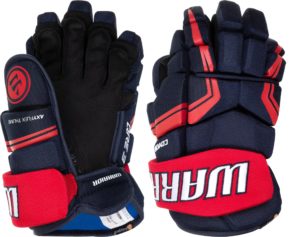 Hockey, like all other sports games, has its own special attributes in the form of sports equipment (stick and puck) and players’ equipment. Since this is a contact and hard sport, the equipment worn by athletes is primarily protective. Protective equipment includes a helmet, goalkeeper mask, protective pads and special gloves.
Hockey, like all other sports games, has its own special attributes in the form of sports equipment (stick and puck) and players’ equipment. Since this is a contact and hard sport, the equipment worn by athletes is primarily protective. Protective equipment includes a helmet, goalkeeper mask, protective pads and special gloves.
Feature of hockey gloves
Hockey gloves, called gauntlets, are one of the elements of sports protective equipment.
Purpose
 Their main task is to provide the maximum possible protection of the player’s hand from blows from an opponent’s stick during play contact. Protecting your hand from a flying puck is also relevant, given that it can reach speeds of over 100 km per hour in flight. At the same time, the player’s gaiters should provide him with comfortable handling of the stick, and, therefore, not hinder the movements of the hand in the joints.
Their main task is to provide the maximum possible protection of the player’s hand from blows from an opponent’s stick during play contact. Protecting your hand from a flying puck is also relevant, given that it can reach speeds of over 100 km per hour in flight. At the same time, the player’s gaiters should provide him with comfortable handling of the stick, and, therefore, not hinder the movements of the hand in the joints.
Attention! Having gloves is a prerequisite for playing professional or amateur hockey.The absence of this item of sports equipment for a hockey player is fraught with serious injury during the game.
Design
In accordance with the requirements for hockey gloves, they have a special design. Standard hockey leggings consist of several elements.

External skid plates
Today they are made of lightweight but durable polymer materials arranged in several layers. This allows the plates to effectively absorb the energy of a flying puck or stick impact. They are distributed throughout the outer part of the glove and have different shapes, depending on their location.
Thumb protector
The thumb occupies a separate position on the hand and, when gripping the club, stands separately from the rest of the hand. This increases the risk of injury while fighting for the puck. A blow to it can lead to a broken bone or dislocated joint.
IMPORTANT! To avoid injury, the thumb in hockey gloves is reinforced with a separate insert.
Cuff
This is another one shield located at the top of the glove. It covers the wrist joint and the lower part of the forearm. The purpose of a protective cuff is to prevent a forearm fracture or wrist dislocation.

Palm
The inner surface of the glove that is in direct contact with the club.
Made from soft but at the same time durable materials - often genuine leather or leatherette. Recently, the palms of the cuffs have also been made from various synthetic fabrics that are highly resistant to abrasion. The fabric of the palms can be single or multi-layered.
Foam pads
Installed under the outer glove guards.They serve to prevent the transfer of impact energy from a stick or puck through a hard shield directly to the hockey player’s hand.
Sometimes soft shock-absorbing pads are also sewn between layers of fabric on the palm of the glove. They soften vibrations when you hit the puck sharply with a stick.
Types of hockey gloves
By purpose
 According to their characteristics of use, gloves are divided into amateur and professional.
According to their characteristics of use, gloves are divided into amateur and professional.
Professional leggings are usually made better quality, using expensive wear-resistant materials. Gloves for professional athletes are also lighter in weight and more comfortable to use.
REFERENCE! The cost of a professional piece of ammunition is significantly higher than that of amateur leggings.
By design
Hockey gloves, in addition to amateur and professional ones, are divided into 2 groups based on their design.
- Anatomical, tightly fitting the hand and more expensive.
- Classic, suitable for any brush, depending on the size.
Nuances of choice
 When choosing gloves for playing hockey, there are a number of rules to consider. This will allow you to choose gloves that can protect your hand as effectively as possible during the match.
When choosing gloves for playing hockey, there are a number of rules to consider. This will allow you to choose gloves that can protect your hand as effectively as possible during the match.
Attention! According to the set of rules of the World Hockey Association, adopted in 2014, protective gaiters must completely cover the hockey player’s hand and wrist.
- When trying on gloves, you should pay attention to the fact that Is the gaiter cuff adjacent to the elbow pad?. If there is an unprotected space between them, you should buy a larger glove or buy additional protection - a wrist guard worn on the forearm.
- Put on a brush the glove should not squeeze the palm too tightly. The brush should feel free in it both in a compressed and open state.
But the choice of a specific model should be made exclusively on an individual basis in order to ensure the most comfortable handling of the stick during the game.


 0
0





